Day 1: Rongai Gate (1,950 meters) to First Cave Camp (2,620 meters)
Your Mount Kilimanjaro trek via the Rongai Route begins with a scenic drive from Moshi or Arusha to the Rongai Gate, located on the quiet northern side of the mountain near the Kenyan border. After registration and a safety briefing, you’ll set off on foot along a peaceful forest trail rarely used by other climbers—making this a tranquil start to your journey.
The trail gently winds through shady montane forest, home to an array of wildlife. Keep an eye out for black-and-white Colobus monkeys leaping through the trees, and listen for the melodic calls of forest birds that accompany your steady ascent. The air is fresh and cool, and the gradual incline is perfect for easing into your high-altitude adventure.
As you emerge from the forest into the moorland zone, you’ll arrive at First Cave Camp by mid-afternoon. Nestled at 2,620 meters, this camp offers your first clear views of Kibo Peak, the iconic summit cone of Kilimanjaro, rising dramatically in the distance.
Enjoy a hearty dinner prepared by your mountain chef, soak in the crisp mountain air, and get a good night’s rest—your adventure has only just begun.
Elevation Gain: 670 meters
Hiking Time: 3–4 hours
Habitat: Montane Forest
Highlights of the Day:
Quiet forest trail with chances to spot Colobus monkeys and birds
Gentle trek perfect for beginning altitude acclimatization
First glimpse of Kilimanjaro’s majestic summit, Kibo Peak
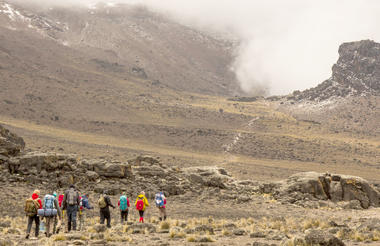
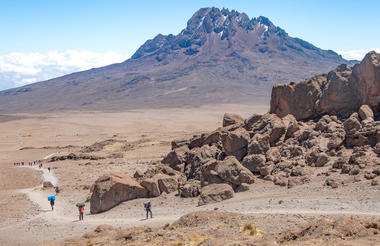
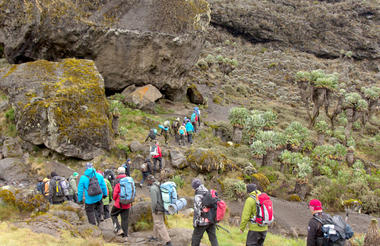
What to Wear:
Lightweight hiking trousers and moisture-wicking T-shirt
Long-sleeve shirt or light fleece for cool forest air
Comfortable hiking boots (well broken-in)
Sunhat, sunglasses, and sunscreen for midday exposure
Day 2: First Cave Camp (2,620 meters) to Second Cave Camp (3,450 meters)
After a restful breakfast at First Cave Camp, you’ll continue your gradual ascent through the moorland zone, where the lush forest of the lower slopes gives way to more open terrain with low alpine vegetation. As you hike, you’ll be treated to sweeping views of the Kenyan plains far below, with the landscape opening up around you. The trail is relatively gentle, making it an ideal opportunity for your body to adjust to the increasing altitude while enjoying the stunning surroundings.
As you gain elevation, the moorland gives way to hardy shrubs and heather, and the vistas expand to reveal Kilimanjaro’s eastern ice fields. On clear days, you’ll be treated to breathtaking views of Mawenzi Peak, the second-highest peak on the mountain, with its jagged, spire-like appearance.
By mid-afternoon, you’ll reach Second Cave Camp, located at 3,450 meters. This scenic camp offers fantastic panoramic views of both Kibo and Mawenzi peaks, making it a perfect spot for relaxing and soaking in the majesty of the mountain.
Take the rest of the day to relax, rehydrate, and allow your body to continue acclimatizing to the increasing altitude.
Elevation Gain: 830 meters
Hiking Time: 4–5 hours
Habitat: Moorland
Highlights of the Day:
Gradual ascent into the moorland zone with expansive views
Spectacular vistas of Mawenzi and Kibo Peaks
Slow elevation gain promoting effective acclimatization
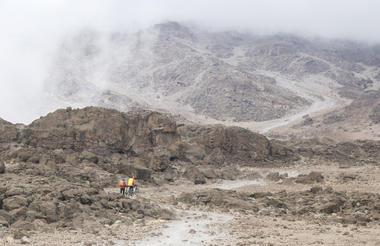
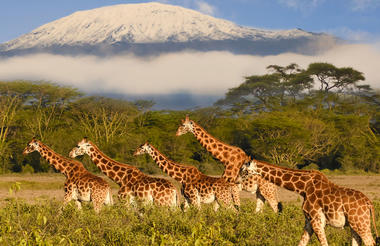
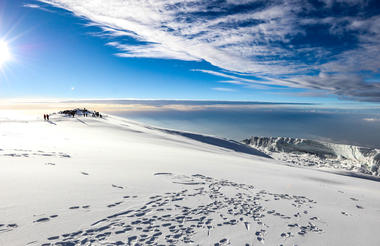
What to Wear:
Long hiking pants and a moisture-wicking long-sleeve shirt
Light fleece or windbreaker for cooler temperatures
Hat, sunglasses, and sunscreen for sun protection
Comfortable, well-broken-in hiking boots
Day 3: Second Cave Camp (3,450 meters) to School Hut Camp (4,750 meters)
On Day 3, your trek takes you deeper into the alpine desert zone, where the landscape becomes more barren and the altitude starts to make itself felt. After breakfast at Second Cave Camp, you'll begin your ascent toward School Hut Camp. The trail today is steeper, with a more noticeable climb, gaining an elevation of 1,300 meters over 5–6 hours.
As you ascend, the vegetation becomes sparser, replaced by rocky terrain and small, hardy plants adapted to the harsh conditions of the alpine desert. This part of the trek is quieter and more remote, with fewer trekkers compared to other parts of the mountain, giving you a sense of peaceful solitude.
Along the way, you’ll be treated to panoramic views of Mawenzi Peak, which continues to loom majestically to the east. You’ll also begin to see Kibo Peak looming in the distance, reminding you of your destination. By the time you reach School Hut Camp, located at 4,750 meters, you'll be nearing the edge of the high-altitude zone.
This camp, located just below the Kibo summit, offers stunning views of Mawenzi and is a great place to rest and acclimatize before the final push toward Uhuru Peak. The higher altitude means that you’ll need to take it slow and steady, allowing your body to adjust as you climb higher.
Elevation Gain: 1,300 meters
Hiking Time: 5–6 hours
Habitat: Alpine Desert
Highlights of the Day:
Steady ascent into the alpine desert with fewer trekkers
Views of both Kibo and Mawenzi peaks
Higher altitude helps with acclimatization for summit day
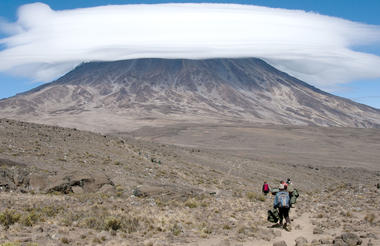
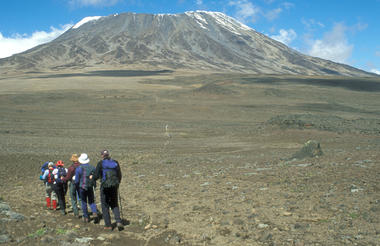
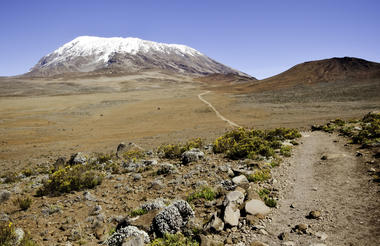
What to Wear:
Long hiking pants and moisture-wicking long-sleeve shirt for sun protection
Lightweight fleece or jacket for cooler, high-altitude temperatures
Sun protection (hat, sunglasses, sunscreen)
Comfortable, supportive hiking boots
Day 4: School Hut Camp (4,750 meters) to Uhuru Peak (5,896 meters) to Horombo Hut (3,720 meters)
Day 4 is the most exciting and demanding day of your trek. The day begins early at School Hut Camp, where you’ll be woken up in the middle of the night for your summit attempt. The goal today is to reach the Roof of Africa—Uhuru Peak (5,896 meters)—the highest point on Mount Kilimanjaro.
The trek to Uhuru Peak begins in the dark hours of the night, so you’ll be using your headlamp as you climb steadily up the steep and rocky path. As you gain altitude, you’ll pass through the Arctic Zone, where temperatures can drop below freezing. Be sure to wear all your warm layers as the weather will be cold and winds can be strong.
The climb to Uhuru Peak takes approximately 6–8 hours, depending on your pace and the weather conditions. The path takes you through Gilmans Point (5,681 meters) on the crater rim, and from there, it’s a short but rewarding walk to the summit at Uhuru Peak. Here, you’ll be rewarded with breathtaking views and a sense of accomplishment that comes from standing at the highest point on the African continent.
After celebrating at the summit, you’ll descend back down the crater rim to Horombo Hut (3,720 meters), where you’ll spend the night. The descent takes about 3–4 hours, and though it’s easier on the body, the long day of trekking will have left you physically drained. Upon reaching Horombo Hut, you’ll enjoy a warm dinner and well-earned rest.
Elevation Gain to Uhuru Peak: 1,146 meters
Elevation Loss to Horombo Hut: 2,176 meters
Hiking Time to Uhuru Peak: 8–10 hours
Hiking Time to Horombo Hut: 3–4 hours
Habitat: Alpine Desert to Arctic Zone (Uhuru Peak), then Moorland (Horombo Hut)
Highlights of the Day:
Summit Day! Reaching the Uhuru Peak, the highest point in Africa
Incredible sunrise views from the summit
Descend through the Arctic Zone and enjoy sweeping vistas of the Kilimanjaro crater
Rest at Horombo Hut, a peaceful camp in the moorland zone
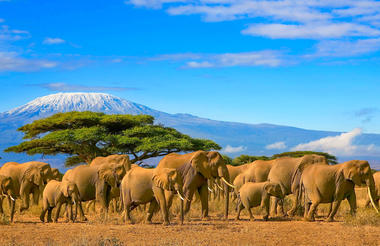


What to Wear:
Base Layer: Moisture-wicking long sleeve shirt and thermal pants
Mid Layer: Insulating fleece or down jacket for warmth
Outer Layer: Waterproof jacket and pants for wind and rain protection
Accessories: Hat, gloves, and scarf to protect against freezing temperatures
Footwear: Sturdy, warm hiking boots with good ankle support
Other: Headlamp (for summit night), sunscreen, and lip balm
Pro Tip: Make sure to take it slow during your summit attempt, drink plenty of water, and remember the mantra “pole pole” (slowly, slowly). Your body needs time to adjust to the altitude, so don’t rush.
Day 5: Horombo Hut (3,720 meters) to Marangu Gate (1,830 meters) to Kilimanjaro International Airport
On Day 5, after a well-deserved rest at Horombo Hut, you'll begin your descent down Mount Kilimanjaro. The descent takes you through lush montane forest and moorland, offering a dramatic contrast to the barren landscapes you encountered on your way up.
The day begins with a hearty breakfast at Horombo Hut, and then you'll head out on a relatively easy descent to Marangu Gate, which is the official exit point for this route. The journey to Marangu Gate takes about 5–6 hours, and along the way, you'll experience a steady decline in altitude as you transition from the higher moorland to the verdant forests.
As you descend, the vegetation becomes increasingly lush, and you’ll be surrounded by towering trees and tropical plants. The path is well-maintained, but can be slippery in places, especially if it has rained. Trekking poles are highly recommended for extra stability during the descent.
Once you reach Marangu Gate, you’ll sign out of the park and receive your Kilimanjaro Certificate—a well-earned reward for your hard work and dedication in reaching Uhuru Peak.
From Marangu Gate, you’ll be transferred back to Mosho or Arusha, or directly to Kilimanjaro International Airport for your flight. After a hot shower, a celebratory meal, and some well-deserved rest, you can reflect on your incredible achievement of summiting Mount Kilimanjaro!
Elevation Loss: 1,890 meters
Hiking Time to Marangu Gate: 5–6 hours
Habitat: Moorland to Montane Forest
Highlights of the Day:
Descent through lush montane forest with a chance to spot wildlife like monkeys and birds
Sign out at Marangu Gate and receive your Kilimanjaro Summit Certificate
Celebrate your achievement at the end of the trek
Return to civilization and your hotel or the airport
What to Wear:
Comfortable hiking pants and a moisture-wicking shirt
Fleece or jacket for warmth in the early morning
Rain jacket in case of light showers during the descent
Good hiking boots with ankle support (helpful for the descent)
Hat, sunglasses, and sunscreen for sun protection in the lower altitudes
Pro Tip:
Take it slow during the descent to avoid joint strain. Your legs may feel tired, so be sure to stay hydrated and take short breaks as needed.
Once you reach Marangu Gate, you’ll be one step closer to completing the ultimate Kilimanjaro trek and celebrating your success!




